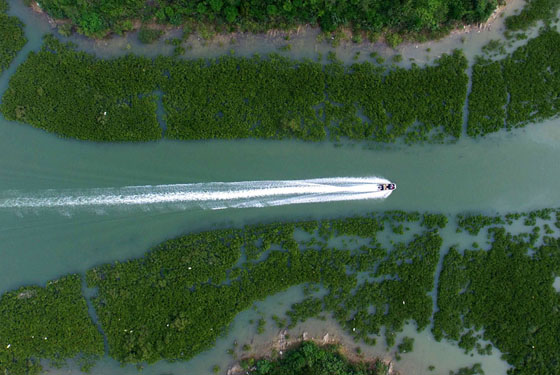Mangrove forest in SW China endangered
- By Wu Jin
 0 Comment(s)
0 Comment(s) Print
Print E-mail China.org.cn, June 8, 2016
E-mail China.org.cn, June 8, 2016
The vast tracts of mangrove forest in the Beibu Gulf of Guangxi Zhuang Autonomous Region have been almost erased by the immense construction of marine reclamation lands and industrial plants.
 |
|
The rapid deforestation of the mangrove woods has posed a grim threat to the eco-environment in the once pollutant-free coastal lands. |
The sharp decline of the mangroves and marine species -- two important signs gauging regional ecological conditions -- indicates devastation resulting from the sprawling industrial bases.
"The land was previously covered with thick foliage. Now, only a few mangroves are still here," said Huang, a fisherman in Beihai City of Guangxi.
"Although saplings have been planted, they'll only be full-grown after a considerable number of years. Also, some may die young."
As a veteran fisherman, Huang knows exactly how beneficial it was for the environment when the mangrove trees stood as green walls abating the howling typhoons.
For the past decade, those trees, prone to devastating lumbering, have been replaced by manmade lands, aquaculture pools and tourist spots. The ruthless industrialization has almost eliminated the coverage of the trees among which only a few have survived, not to mention those currently dying or covered with sparse foliage.
The Beibu Gulf in Guangxi has more than once been affected by the stunning attacks of sphaeroma, a marine parasite which is detrimental to trees.
Last September, a parasitic disaster swept through the mangroves, leaving hundreds of hectares of trees withered during the disaster. The local farmers had no choice but to burn the dead trees, including those more than 10 years old.
"Those disasters are globally rare," said Fan Hangqing, director of the Mangrove Woods Research Center of Guangxi Zhuang Autonomous Region.
Mangrove trees generally grow in several regions and provinces in China, such as Guangxi, Hainan, Guangdong, Fujian and Taiwan, and the size of the woods were especially huge in the Beibu Gulf of Guangxi. Currently, the coverage of mangrove trees in the Beibu Gulf has diminished by over 0.7 percent each year.
The deforestation and pest disasters inflicting damage on the environmental conditions in the Beibu Gulf probably stand as testimony to the severe industrial pollution from cities like Beihai and Qinzhou where the sewage has been released towards the estuaries of the Beibu Gulf.
"Severe pollution has been caused and the air is replete with suffocating smells emitting from neighboring pigsties and the dark swages are directly released from factories into the sea," said A Hua, an environmental protection volunteer in Beihai City.
An official report on the environmental conditions of the coastal area issued in Guangxi has shown that the sea water near the shore has been severely contaminated by the pollutants majorly consisting of inorganic nitrogen, petroleum related substances and reactive phosphate. The water quality in some parts of the area has been downgraded to Class Four, the second lowest level of a measurement categorizing the water quality from best to worst.
An anonymous official in Guangxi revealed that the environment has been damaged since the region launched several big industrial projects, such as steel, paper and petroleum manufacturing, after the establishment of the Beibu Gulf Economic Zone, which has contributed to land reclamation measures.
From 2000 to 2007, Beihai, Fangchenggang and Qinzhou reclaimed 962 hectares of land from the sea area. However, during the following five years — 2008-2012 — the land reclamation soared to a total of 5,108 hectares in the same cities.
Along the undulating tree belts, several bulldozers were rumbling at the construction sites.
Simply because mangrove trees can hardly yield any profitable economic returns, they have been cut down to make place for the development of more profitable industries, said Fan.
Ocean areas near the Beibu Gulf receive 400-million-ton household wastewater as well as 100-million-ton industrial sewage each year.
"The inland sources of pollutants as well as the direct release of sewage can result in the eutrophication of sea water, reflected by the outburst of algae, red tides and the prevalent parasitic disaster," said A Li, a veteran volunteer engaged in the protection of oceanic ecological systems.
"The remnants of fodder, excretion, disinfectants and poisonous chemicals inside the sewage have caused great damage to the mangrove trees and fish species near the shore," A Li continued.
The deteriorating environmental conditions in the Beibu Gulf have drawn numerous concerns from the experts who proposed the timely restoration of the ecological system in the region.
"Urban construction should not take up the land covered by mangrove trees. If it really needs to, people involved in the project should plant new trees in accordance with the regulations issued by the local oceanic and forestry administrations to ensure the conservancy of the woods in a stable size," Fan said.
The experts also encouraged subsidies for small aquaculture businesses so that the owners are able to install facilities to reduce the pollutants of the sewage before it is discharged. They also recommended the use of methane gas and organic fertilizers to reduce the pollution caused by the excretion of poultry and livestock and proposed laws to regulate the sewage release from manufacturing bases.






Go to Forum >>0 Comment(s)